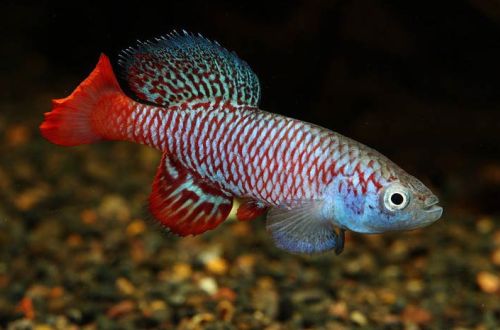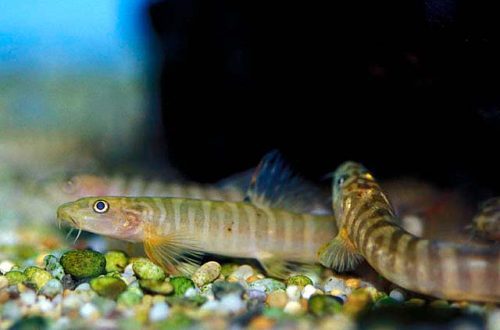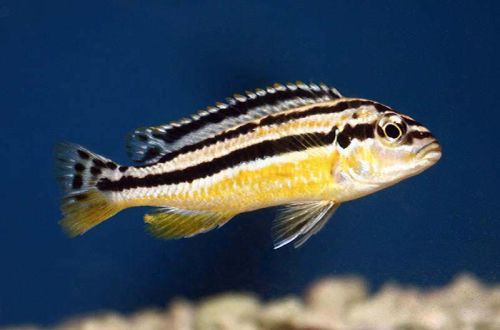
sickle-tailed barracuda
sickletail The barracuda, scientific name Acestrorhynchus falcatus, belongs to the Acestrorhynchidae family. The word “barracuda” is used as a description of the fish because of its superficial resemblance to a member of the marine fauna, with which it is in no way related. It is easy to keep and can be recommended for beginner aquarists. However, the installation and launch of the aquarium should be entrusted to professionals.

Contents
Habitat
It comes from South America, is widespread in the northern part of the Amazon, in the territory of modern Guyana, Suriname, French Guiana, as well as the northern part of Brazil and Peru. The natural habitat of this species is the channels of rivers and their tributaries, the water in which has a brown tint due to the abundance of tannins and other tannins. The source of these substances are plant residues (branches, leaves, fruits), which are abundant in tropical forests.
Brief information:
- The volume of the aquarium – from 250 liters.
- Temperature – 22-28°C
- Value pH — 6.0–7.5
- Water hardness – soft (2-12 dGH)
- Substrate type – any
- Lighting – subdued
- Brackish water – no
- Water movement – moderate or weak
- The size of the fish is 25–27 cm.
- Food – pieces of fish
- Temperament – conditionally peaceful
- Content alone or in a group
Description
The fish are quite large, adults reach a length of about 25–27 cm. Sexual dimorphism is weakly expressed, males are practically indistinguishable from females, the latter grow somewhat larger.
Outwardly, it resembles its close relative, the Red-tailed Barracuda, which is why they are often confused and sold under the same name. The main difference between the sickle-tailed barracuda is the shape of the tail, resembling a sickle, which is reflected in the name of the species. Otherwise, they are similar. The body is elongated, with pointed fins shifted towards the tail. The color is pinkish or silvery. The tail is red with a black spot at the base. The upper jaw is hook-shaped, and the mouth is studded with sharp teeth.
Food
True predator. Wild-caught sickle-tailed barracudas may refuse any food other than live fish in an aquarium. However, such specimens are rarely found outside the two Americas. In Europe, fish already grown in an artificial environment are on sale. They are able to accept fresh and even dried pieces of fish.
You can not feed products of animal origin and birds.
Maintenance and care, arrangement of the aquarium
If you are not a professional aquarist, then in the case of acquiring such a predatory fish, the arrangement and launch of the aquarium should be entrusted to specialists. The minimum volume of an aquarium for one adult fish starts from 250 liters. The presence of a cover is mandatory to prevent accidental jumping out. Prefers open water, so clearance should be kept to a minimum. High decorative elements should be placed along the walls. The presence of plants is welcome, but they should not be allowed to overgrow. Always keep a large open space.
The quality of the water is of decisive importance. The presence of an effective filtration system and the regular replacement of part of the water with fresh water will help to avoid the accumulation of organic waste and surges in the concentrations of hazardous compounds (nitrites, nitrates, etc.). To give the water a brownish tint, characteristic of the natural habitat, the essence of the leaves of the Indian almond tree is used or the leaves or bark themselves are placed in the aquarium. In the process of decomposition, they release tannins and thereby give the water a tea shade.
Behavior and Compatibility
Relatively peaceful considering her predatory nature. Safe for large fish of comparable size, as well as well-protected catfish. Intraspecific conflicts were not noted, they can live both singly and in a group. However, cannibalism is possible if fish of different sizes are placed together. Not compatible with aggressive, territorial and small fish.
Breeding / breeding
Breeding in home aquaria is possible, but extremely rare. Breeding is carried out for commercial purposes on specialized fish farms or professional aquarists.
Fish diseases
Like any predator, it is a hardy and unpretentious species. The main causes of most diseases are unsuitable conditions of detention. Therefore, if the behavior and color of the fish has changed, redness, ulcers, etc. have appeared on the body, first of all, the quality and composition of the water, as well as the excess concentration of hazardous substances, should be checked. In case of detection of deviations from the norm, this problem is first solved and only then a diagnosis is made and treatment begins. In some cases, the restoration of optimal water conditions leads to a cure for the fish. Read more about symptoms and treatments in the Aquarium Fish Diseases section.





